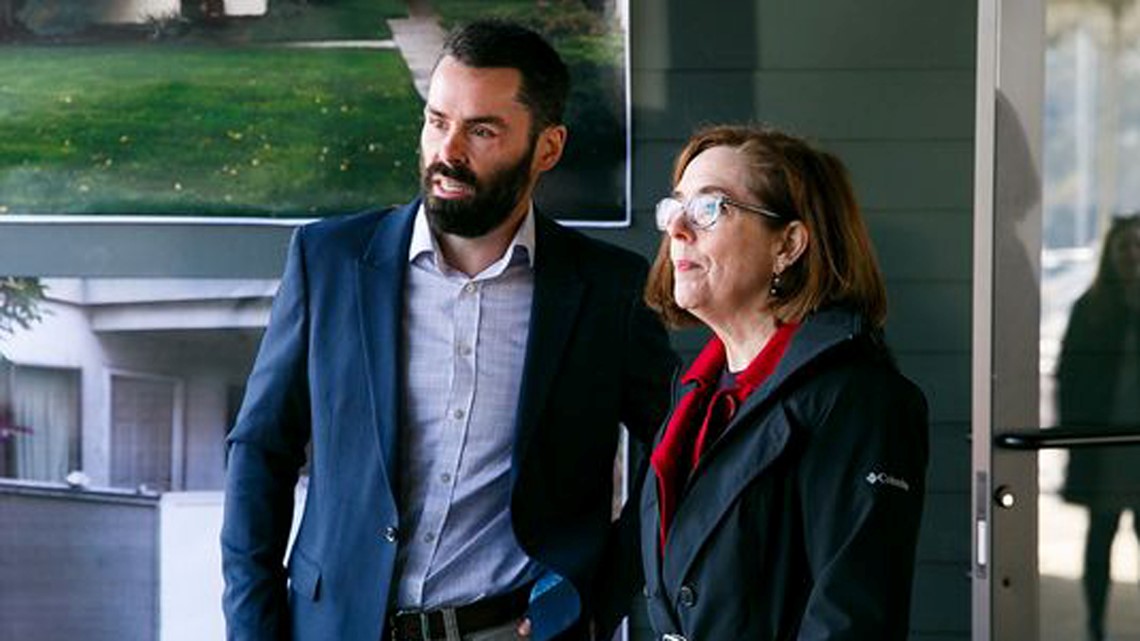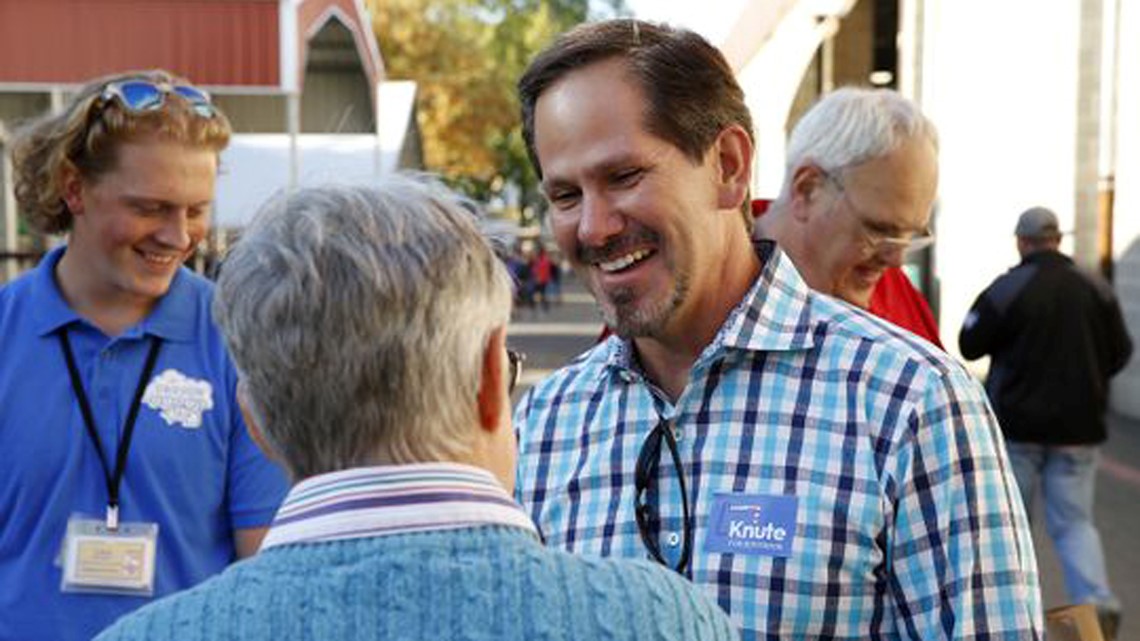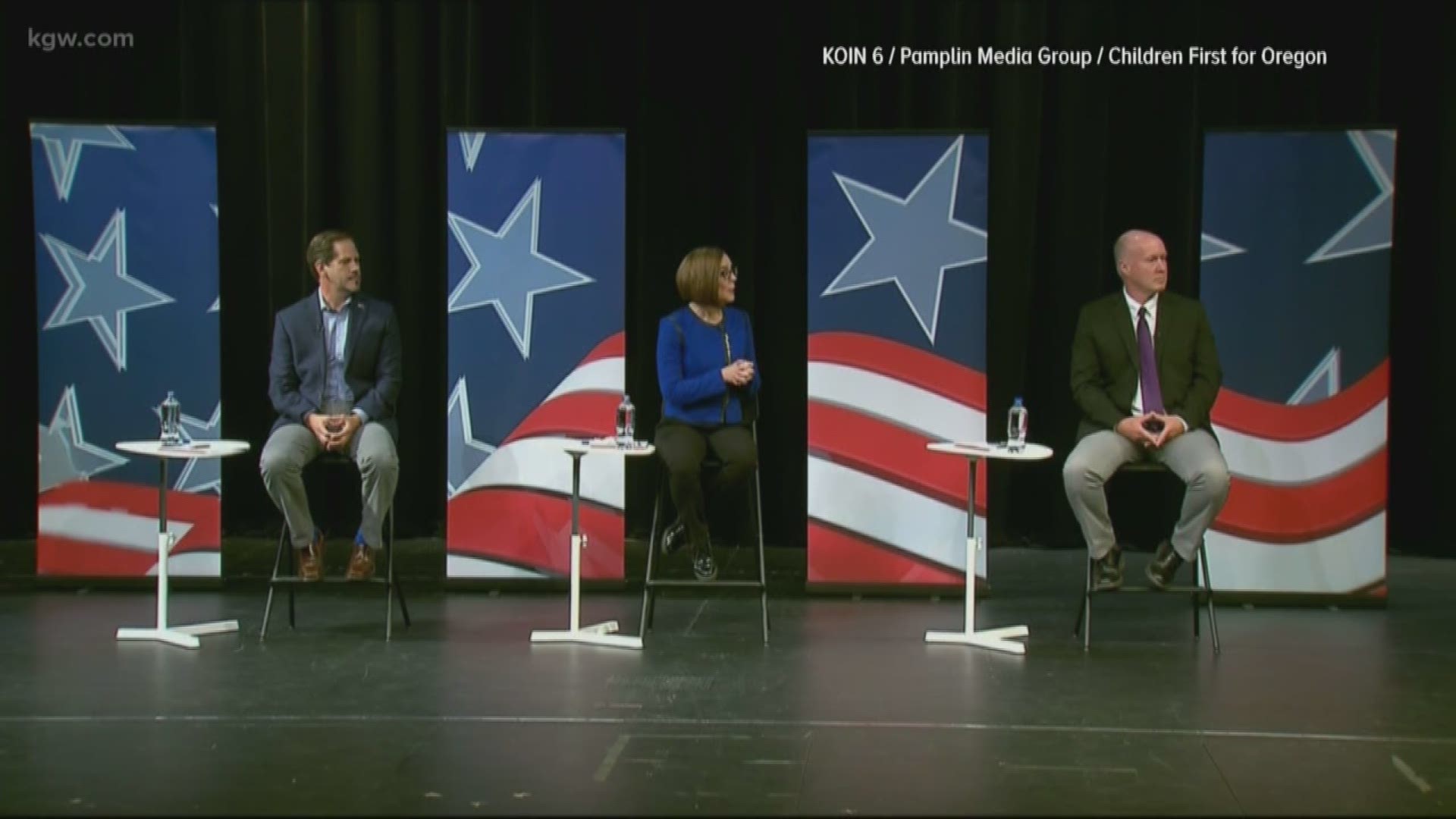After Tuesday night, Oregon's main candidates for governor will have faced off in three debates along the I-5 corridor, touching on some of the most important issues facing the state.
The first debate was in Portland last Tuesday from 7 p.m. to 8 p.m, hosted by Children First for Oregon, Pamplin Media Group and KOIN 6 News. The next was Oct. 4 in Medford, and the third is Tuesday night in Portland.
The Tuesday debate airs live on KGW-TV at 7 p.m. It will also be streamed live on KGW's Facebook page, on KGW.com, on KGW's YouTube channel, and on the KGW News app.
In the Oct. 2 debate, the candidates were questioned by children and teenagers. All three major party candidates for governor were in attendance.
Democrat Gov. Kate Brown is running for another term in office, having first ascended to the job in Feb. 2015 after John Kitzhaber's resignation, and then winning a special election in 2016.
Rep. Knute Buehler, R-Bend, is Brown's main challenger, a rematch of the 2012 race for secretary of state. If elected, he would be the first Republican governor since Vic Atiyeh left in 1987.
From the Independent Party of Oregon, Patrick Starnes, a cabinet maker and house restorer from Brownsville, is running on a platform of rooting big money out of Oregon politics. He has said all other issues facing the state are unsolvable until campaign finance reform is achieved.
State political analysts don’t give Starnes much of a chance at winning. His campaign infrastructure is nonexistent compared to the Republican and Democratic competitors and he lacks their name recognition.
At Tuesday's debate, he hopes to convince voters more broadly of the importance of campaign finance reform.
For Brown and Buehler, here's a breakdown of their positions on five issues likely to come up during the debates leading to the Nov. 6 general election.
A general agreement on health care
Oregon politicians have long touted the state's history of expanding health care access to as many residents as possible.
Since the implementation of the Affordable Care Act in 2014, the number of Oregonians with health care has increased 10 percentage points to 94 percent this year.
One of Brown's accomplishments on this front is the passage of the "Cover All Kids" bill in 2017, which extended coverage under the Oregon Health Plan to an estimated 15,000 children in the country without documentation.
Buehler voted against this bill, arguing that the state shouldn't be spending $36 million to expand services to a new population while failing to adequately fund existing programs.
But, when it comes to health care, the two candidates are largely on the same page as to what they want to see accomplished in the coming years.


Both candidates want to: integrate mental and physical health care; grow mental health and addiction services; dramatically reduce the number of opioid overdose deaths; combat rising health care costs, particularly in prescription drugs; complete the so-called CCO 2.0 Medicaid reform to modernize health care in the state.
Both candidates also oppose attempts by the federal government to cut state Medicaid funding.
Despite the general agreement, there is always space on the margins to fight.
One example, Buehler has criticized Brown for what he considers the slow implementation of Medicaid reform, saying on his website that it "stalled out for lack of gubernatorial leadership."
The current contract for Coordinated Care Organizations ends in 2019. Earlier this year, the Oregon Health Authority put out a call for public comment on the new program and Brown sent a letter to policy makers outlining her hopes for the new system.
Repealing Oregon's sanctuary law
In one of the most blatant disagreements of the campaign, Buehler said in July he will vote to undo Oregon's 31-year-old sanctuary state law when given the opportunity to in several weeks.
But Buehler has also said he supports the central tenet of the law, that local law enforcement shouldn't double as federal immigration officers.
"There’ll be no resources that go to that, no local resources to enforce federal immigration policy," Buehler told OPB during an interview.


Buehler has said that local law enforcement and federal officials should be able to communicate about an individual's immigration status. Existing law, he said, is not clear as to what is allowed.
"The current law is causing confusion, and there’s different interpretations from judges, sheriffs, and district attorneys," he said in a statement. "I support the measure, but will not campaign for it."
Brown has come out strongly against Measure 105, the initiative that will allow voters to decide the fate of this immigration policy.
The sanctuary state law prohibits Oregon law enforcement agencies from using public resources to arrest individuals whose only crime is violating federal immigration law. It's become a model for other states and cities looking to enact similar legislation.
Similar goals for education
Politicians have promised voters for years to fix the state's education system — from funding disparities and large class sizes to Oregon's short school year and declining attendance rate.
Both Brown and Buehler want to increase school funding, lengthen the academic year, offer more college and career opportunities, increase graduation rates and diversify teaching staff.
But they differ in their proposed solutions and how long it will take to achieve success.
In her education plan, Brown says allocating money to initiatives that help students and families facing the most barriers are large investments with long-term dividends.
Her plan focuses on expanding pre-school options, reducing class sizes and investing at least $300 million in career technical courses and the High School Success fund, also known as Measure 98. She also plans to offer more scholarships for ethnically and linguistically diverse teaching candidates.
"How our state provides for the needs of children ... is a marker of who we are as a community," Brown said in her plan.
Buehler wants to reform the state public employee retirement system to provide more money for schools and has pledged to lead Oregon out of the bottom five in national education ranking to the top five in five years.
His plan proposes a 15 percent funding increase to schools on the next two K-12 budgets, assuming the Legislature can bring in $1.2 billion each biennium via PERS reform.
He also set new goals for English Language Learners, wants to eliminate certain barriers to bring in more teachers, plans to fully fund career education via Measure 98 and says he will require state and local government employees to contribute more toward their benefits.
"For too long, Oregon's elected leaders have tolerated too many poor-performing schools," Buehler wrote in his plan. "Oregon ... has been denied the full potential of its greatest resource — talented young people ready for college, work, careers and the world."
Abortion rights taking center stage
The subject of Buehler’s stance on abortion rights has been a focal point of the gubernatorial campaign.
He has stated repeatedly in forums, to reporters and to voters that he is pro-abortion rights and believes the decision to have an abortion should remain between a woman and her doctor.
Buehler says he wants abortions to be as rare as possible, particularly through increased access to contraceptives. In his health care plan, Buehler says he wants to reduce the rate of unintended pregnancies by 25 percent over the next five years.
He and Brown both oppose Measure 106, which would prohibit the use of public funds for abortions.
But abortion rights advocates and Brown's campaign are trying to convince the public that Buehler does not deserve to call himself “pro-choice.”
Their case against Buehler largely rests on what abortion access advocates call inconsistent or out-of-touch statements, and his vote last year against House Bill 3391. The bill, which Brown signed into law, requires insurance companies to cover abortions and other reproductive health services at no cost to the patient.
Democrats say that vote was Buehler's best opportunity to prove he is "pro-choice." But Buehler says his opposition was because he considered it fiscally irresponsible to fund a new program while others were losing funding.
Brown is staunchly pro-abortion rights. Her position is backed up by campaign contributions — Emily's List, a national political group that supports female pro-abortion rights candidates, contributed $500,000 to Brown's campaign in August.
Combating rising homelessness
Oregon is one of many states across the country — especially in the West — dealing with the growing problem of homelessness and housing insecurity.
According to a biennial point-in-time survey, nearly 14,000 people in Oregon were classified as experiencing homelessness in 2017, a 6 percent increase from two years prior. The majority of those people were unsheltered. Nearly a quarter were considered chronically homeless.
Brown and Buehler both released policy plans detailing how they would try to fix this problem. Buehler partially blames the governor for failing to lead on this issue and letting it get worse during her tenure.
The governor's plan prioritizes ending childhood homelessness and housing homeless veterans, investing in permanent supportive housing and increasing the number of affordable homes in Oregon.
Brown's plan includes: developing 2,200 to 2,600 units of affordable owner and rental housing, raising $50 million more for Emergency Housing Assistance and the State Homeless Assistance Program, using bonding to acquire or preserve affordable housing options, incentivizing housing development, and providing rental assistance to families.
Buehler's plan is designed around a goal of ending unsheltered homelessness in the state by 2023.
Within those five years, Buehler wants to: create an additional 4,000 temporary and 4,000 supportive-housing beds, build 20,000 new housing units for lower- and middle-income individuals and families, and provide $50 million in direct rental assistance.
He said he also will dedicate more funds to "street-level" mental health treatment and enhance job training programs to end the cycle of poverty that can lead to homelessness.
And because homelessness is such a visible problem, especially in Portland, it could be a particularly important issue raised in Tuesday's debate.
Reporter Natalie Pate contributed to this report.
Contact the reporter at cradnovich@statesmanjournal.com or 503-399-6864, or follow him on Twitter at @CDRadnovich

